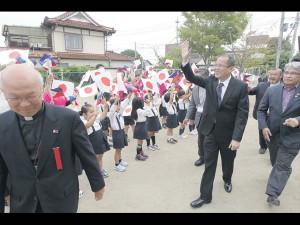
KINDER GREETING President Aquino gets a warm welcome upon his arrival at Ishinomaki Kindergarten for a meeting with the Filipino community in line with his working visit to Japan. MALACAÑANG PHOTO
ISHINOMAKI CITY—Everything seems back to normal in this sleepy rural city north of Tokyo.
Businesses open as usual, workers walk down the asphalt roads, children play in front of houses, many of them recently refurbished—all a testament to the enduring Japanese resiliency in the face of calamity.
That is until you walk past the three-story Kadonowaki Elementary School—or what is left of it—standing a few hundred meters from the coast.
Described by President Benigno Aquino III as something similar to a ravaged building in a war movie, the school serves as a reminder to locals that, six months after Japan was hit by the worst tsunami in recent memory, some things still aren’t right.
Mr. Aquino on Monday motored to the city to see firsthand how waves the size of buildings triggered by a 9-magnitude earthquake swept away nearly half of the area and killed hundreds of people on March 11.
Among the casualties here was a Filipino resident, one of four compatriots who died in the different affected areas in Miyagi, based on Philippine Embassy records. There were 1,218 Filipinos residing in the administrative region as of December last year.
The President spent more than an hour on the bullet train, which no longer stopped at the station in Fukushima, site of a tsunami-induced nuclear meltdown that took weeks to contain, for lack of passengers.
$1-million donation
Mr. Aquino, said to be the first head of a foreign government to visit Ishinomaki after the tsunami, brought with him a $1-million donation drawn from his social fund, or what critics regard as the President’s pork barrel.
He personally handed over a letter pledging the donation to city officials led by Mayor Hiroshi Kameyama.
Transportation Secretary Manuel Roxas II, who was part of the presidential delegation, said Kameyama and fellow officials were very thankful for the donation. They showed their gratitude by bowing several times to Mr. Aquino during the turnover, Roxas said.
Roxas noted that despite the tsunami, Japan would retain the $3 billion in official development assistance that it was extending to the Philippines this year.
Rousing welcome
“Of course, the money is not that big given the enormity of the damage,” the President later told some 150 Filipinos gathered at the kindergarten school run by the Catholic Church.
“But this was what our people could raise from the bottom of our hearts as a reminder that we are one with them in this hour of need,” he said.
Beyond the cash donation, Mr. Aquino’s visit to Ishinomaki sought to uplift the spirit of Filipino and Japanese residents alike. He arrived to a rousing welcome particularly from Filipinos representing the areas of Sendai, Minamisanriku, Iwate and Fukushima.
“Our lives are not yet back to normal. We are still struggling with the effects of radiation on our health. Many of us lost homes,” one of the residents, Kathryn Goto, told the President in Filipino.
“(But the tragedy) inspired us to put up the ‘Hawak-Kamay Fukushima’ (organization) in April to help our fellow Filipinos and our Japanese neighbors,” Goto added.
Mr. Aquino later shared a piece of advice which he said he got from his priest-confessor: “Our faith is simple—there is a God that loves us. And because He loves us, He has a beautiful plan for us.”
“So this is what we should do—we fall but we rise and rise again,” he said in Filipino.
“This country is very good at rising in the face of the many tragedies it has gone through… The key to solving a problem is to not shoulder it alone, knowing that there are others willing to help.”
Before meeting with the Filipino community, Mr. Aquino visited Ishinomaki Elementary School to lay a wreath in remembrance of the victims, many of them teachers and pupils. He laid the wreath next to a stuffed toy and food items offered by previous visitors at a makeshift shrine in front of the school.
Sad traces
The President saw sad traces of what transpired past 3 p.m. that fateful school day in March. According to one account, an initial wave came rushing in, prompting the teachers and pupils to climb to the rooftop.
But what killed many of them were the subsequent waves, which were bigger and more violent.
“First there was a mild snow. Then the sky dimmed. Many birds suddenly went flying away from the sea. Then came an eerie sound and before we knew it, the water was rising,” Corazon Kiuchi, 52, told the Philippine Daily Inquirer.
When the waves finally stopped coming, the school building remained standing but was wrecked from inside: some rooms caught fire, shattered glass and broken furniture lay everywhere.
The ruins of Ishinomaki showed Mr. Aquino that more had to be done to help the city get back on its feet. But his presence was enough to show that compassion knows no rich-and-poor divide in the brotherhood of nations.